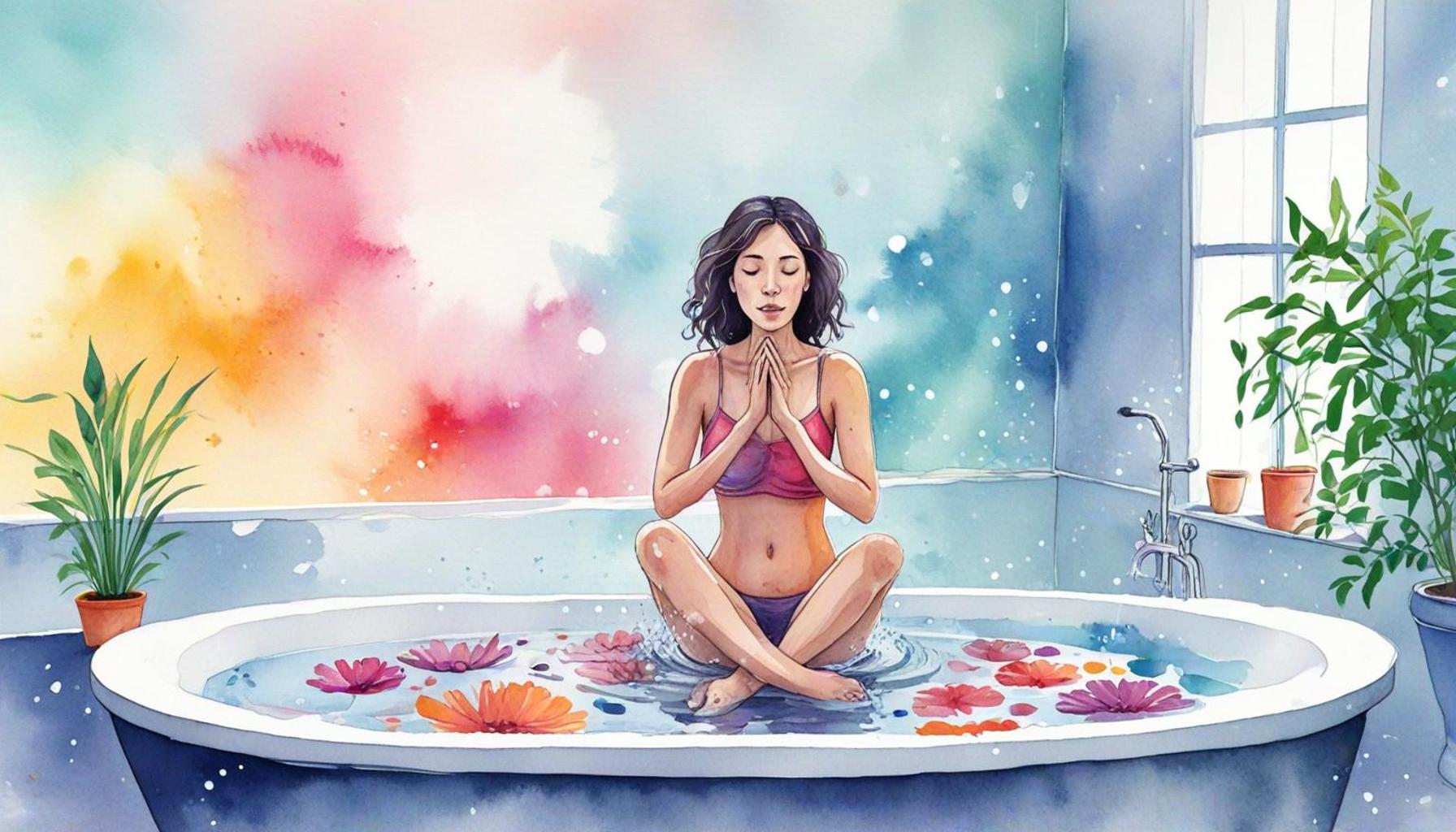Breathing Techniques to Incorporate into Bath Meditation

Unlocking Serenity through Breath and Water
Incorporating breathing techniques into your bath meditation can transform a simple soak into a profound journey of relaxation and self-discovery. This powerful duo not only calms the mind but also enhances the body’s overall wellness. With the serenity of water and the intentionality of breath, you can create a holistic experience that clears mental clutter.
Benefits of Breathing Techniques
- Reduces stress: Focused breathing helps alleviate tension, making it an essential component of meditation. Studies show that conscious breathing can lower cortisol levels, the hormone associated with stress, creating a more serene state of mind.
- Improves concentration: Deliberate breathing encourages a deeper mental focus, enhancing your meditation. By training your mind to concentrate on your breath, distractions fade, allowing for a more fruitful meditative experience.
- Promotes mindfulness: Connecting your breath with your surroundings fosters a greater awareness of the present moment. In vibrant environments like Nigeria, where the hustle can overshadow inner peace, this awareness becomes crucial for finding balance.
Embracing these techniques can be especially impactful in a vibrant setting like Nigeria, where the hustle and bustle can overshadow the need for peace. Imagine taking a restorative bath filled with calming scents, surrounded by the soft murmur of nature. With a gentle breeze whispering through open windows or the distant calls of birds, your bath transforms into a sanctuary. Whether you prefer to meditate in the early morning, accompanied by the sun’s first rays, or in the evening, after the day’s commotion has settled, the integration of breath and water cultivates a serene space for introspection.
Simple Techniques to Get Started
- Diaphragmatic Breathing: Engage the diaphragm for deeper, more efficient breaths. This technique increases oxygen intake, promoting a sense of calmness and relaxation. To practice, place one hand on your chest and the other on your abdomen; focus on inflating your abdomen rather than your chest as you breathe.
- 4-7-8 Breathing: Inhale for 4 seconds, hold for 7, and exhale slowly for 8 seconds. This method can help reduce anxiety and enhance your overall sense of well-being. It effectively resets your breathing pattern, especially after a stressful day.
- Box Breathing: Inhale for 4 seconds, hold for 4, exhale for 4, then hold again for 4. This technique is particularly beneficial for those new to meditation, as it provides a structured rhythm to focus on.
As you immerse yourself in your next bath meditation, remember to breathe deeply. Allow the warm water to embrace you while your mind follows the flow of your breath. This guide will explore various breathing techniques to enhance your experience and promote a tranquil mind and body. Dive deeper into this practice, and discover how a dedicated moment for yourself can ignite a sense of peace in your daily life. In today’s fast-paced world, such rituals are not just a luxury; they are a necessity for holistic health and wellness.
RECOMMENDED: Check out this similar article
Enhancing Your Bath Meditation with Breath
When we consider the art of bath meditation, the role of breathing techniques can’t be overlooked. The synergy between water and breath creates a transformative experience, setting the stage for profound relaxation and clarity of mind. By mastering specific breathing patterns, you can amplify the benefits of your bath, turning a simple moment of respite into a full-body renewal. This practice takes on added significance in a country like Nigeria, where daily life can be frenetic and overwhelming, making the act of slowing down all the more essential.
Understanding the Science of Breath
Breathing is a vital function that many take for granted; however, the method and quality of our breath can significantly affect our psychological state. Scientific research supports the notion that controlled breathing can induce a state of calmness, decrease anxiety levels, and improve overall mental health. As you engage in breath-focused meditation during your bath, you can not only soothe the mind but also create a favorable environment for body healing. Emphasizing controlled breathing techniques reinforces this relationship between the breath and the body’s physiological responses.
Implementing Breathing Techniques
To effectively incorporate breathing techniques into your bath meditation, consider the following practical methods:
- Nasal Breathing: Breathing through the nose, rather than the mouth, can enhance the quality of breath. This method warms and filters the air, while also activating the diaphragm. It can be easily integrated into your bathing routine by focusing on inhaling and exhaling through your nose as you soak in the warm water.
- Equal Breathing: This technique involves inhaling and exhaling for the same duration, creating a sense of harmony and balance. Try inhaling for a count of four and exhaling for four as you immerse yourself in the bath. This practice calms the nervous system and promotes tranquility.
- Mindful Breathing: Simply pay attention to your breath. Notice the rhythm, the temperature of the air, and how it feels entering and leaving your body. This practice encourages mindfulness, pulling you away from the distractions of daily life and drawing you into the present moment.
As these techniques become second nature, you may find that they enhance not only your bath meditation but your life beyond the tub. Each breath taken in this intentional practice creates space for healing and reconnection—not only with yourself but also with the natural environment around you. In a culturally rich nation like Nigeria, where communal ties and traditions often shape personal practices, these techniques remind you of the importance of self-care carved from serene solitude.
Bath meditation marked by focused breathing serves as more than just a relaxing escape; it does much more. Infusing this practice into your daily life may unlock deeper emotional awareness and physical rejuvenation. The journey to serenity through breath and water could be precisely what your mind and body crave amidst today’s whirlwind of activities.
| Breathing Technique | Benefits |
|---|---|
| Deep Belly Breathing | Promotes relaxation, reduces stress, and increases oxygen flow. |
| Box Breathing | Enhances focus and mental clarity, useful for insight during meditation. |
| Alternate Nostril Breathing | Balances energy levels, helping to create a sense of harmony and peace. |
| 4-7-8 Breathing | Calms the nervous system and aids in settling the mind effectively. |
| Mouth Breathing | Useful for releasing accumulated stress, facilitating a deeper relaxation. |
Incorporating these breathing techniques into your bath meditation practice not only enhances the experience but also fosters a profound connection with your inner self. Each technique brings unique benefits, sparking curiosity and inviting you to explore how they can transform your meditation sessions. Deep Belly Breathing, for instance, allows you to tap into your body’s natural relaxation response, flooding your system with calming oxygen. Meanwhile, Box Breathing cultivates focus, paving the way for deeper insights during these moments of stillness. Engaging in practices like Alternate Nostril Breathing offers a fascinating balance of energies, conjuring feelings of harmony that resonate within the tranquil setting of your bath. Techniques such as 4-7-8 Breathing work wonders in calming heightened anxiety, while mouth breathing can release built-up tension, setting the stage for a restorative experience. All these methodologies converge to create a rich tapestry of mindfulness, urging you to delve deeper into your personal journey of relaxation and clarity. Explore how breathing can be a transformative element in your meditation rituals.
CHECK OUT: Click here to explore more
Deepening Your Experience with Advanced Techniques
As you become more familiar with foundational breathing techniques, you may seek to deepen your bath meditation experience. Incorporating advanced practices can lead to heightened states of relaxation and awareness. Here are several techniques that can further enhance your journey of self-discovery and tranquility during your bath meditation.
Box Breathing
Box breathing is a technique often used by athletes and military personnel to maintain focus under pressure; however, it’s also exceptionally effective for calming the mind during meditation. This method consists of four equal parts, akin to the shape of a box. Begin by inhaling through your nose for a count of four, holding the breath for another four, then exhaling through your mouth for a count of four, followed by another pause for four counts before inhaling again. This rhythmic approach not only helps regulate your breath but also creates a sense of groundedness that can be especially beneficial in the hectic pace of daily life.
Progressive Muscle Relaxation
Another excellent method to integrate with your bath meditation is progressive muscle relaxation. This approach involves tensing and then relaxing different muscle groups in conjunction with your breath. As you inhale, tense a group of muscles (for example, your shoulders or feet), hold the tension for a few seconds, and then exhale while releasing that tension. This connection between breath and physical relaxation can lead to a more profound sense of ease throughout the body and is particularly useful after a long day navigating the complexities of life in a bustling environment like Lagos or Abuja.
Visualization with Breath
Incorporating visualization with breath can truly elevate your bath meditation experience. As you breathe in, visualize drawing in positive energy, tranquility, and light. Conversely, as you exhale, imagine letting go of stress, negativity, and any burdens you carry. This dual application of breath and imagery not only aids in relaxation but also cultivates a positive mindset. The synergy of a serene bath environment and focused visualization can be profoundly restorative, making the experience a cherished ritual in your self-care routine.
Utilizing Aromatherapy
To enhance your breathing practice during bath meditation, consider integrating aromatherapy into your space. Essential oils like lavender, eucalyptus, and chamomile can enrich your breathing experience. When you combine pleasant aromas with your breathing techniques, it can amplify relaxation and promote mental clarity. For instance, adding a few drops of lavender oil to your bath water can create an inviting atmosphere that harmonizes beautifully with your breath-focused meditation.
Furthermore, as you connect breath with fragrant oils, reflect on the scents’ cultural significance. In many Nigerian traditions, essential oils from natural herbs are believed to possess healing properties. Infusing such elements into your bathing ritual not only enhances the aroma but also fosters a connection to heritage and ancestral wisdom.
These advanced breathing techniques provide new dimensions for your bath meditation, allowing you to interact with your body and mind more intricately. By practicing these methods regularly, you may experience tangible benefits such as improved emotional well-being and a heightened sense of calm. In a society where self-care is often sidelined, embracing these techniques can pave the way for a healthier, more balanced lifestyle.
YOU MAY ALSO LIKE: Read read another article
Conclusion
Incorporating breathing techniques into your bath meditation can profoundly transform your self-care practices, offering a unique pathway toward relaxation and self-discovery. As we’ve explored various techniques—from the structured calm of box breathing to the immersive experience of visualization—you can cultivate a sanctuary within your bathing ritual. Each method serves to deepen your connection with your body and mind, helping to alleviate stress and enhance your overall well-being.
The use of aromatherapy adds an additional layer of serenity, connecting sensory experiences to the benefits of mindfulness. For many in Nigeria, these practices resonate beyond the bath; they connect with traditional beliefs about natural herbs and oils that promote healing and balance. By integrating these ancient practices with modern techniques, you bring forth a rich tapestry of cultural significance and personal growth.
As you embark on your journey with these breathing techniques, remember that consistency breeds comfort and familiarity. Tailoring your meditation to include elements that resonate with you—whether it’s a favorite essential oil, a specific breathing pattern, or the visualization of your dreams—will create a bathing experience that is uniquely yours. Ultimately, these practices not only create moments of respite but also empower you to carry the tranquility of your bath meditation into daily life.
Embrace these techniques as tools for nurturing emotional resilience and a balanced lifestyle in today’s fast-paced world. Let each breath you take in your bath be a step toward rejuvenation and peace, inviting you to explore deeper layers of your personal journey.



